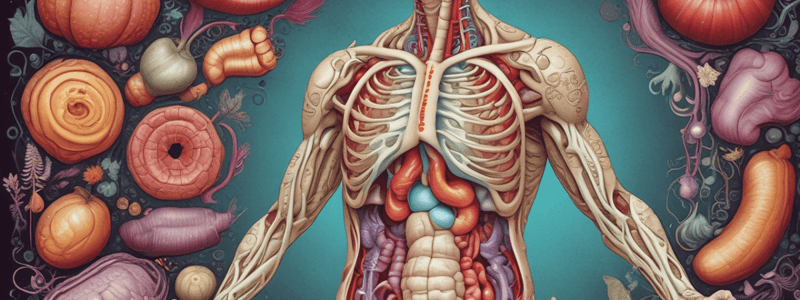Podcast
Questions and Answers
What is the primary function of bile in the digestive process?
What is the primary function of bile in the digestive process?
- Breaking down carbohydrates
- Regulating digestion and absorption
- Breaking down proteins
- Breaking down lipids (correct)
What is the significance of pancreatic juice in digestion?
What is the significance of pancreatic juice in digestion?
- Breaking down carbohydrates, proteins, and fats (correct)
- Producing bile
- Adding bulk to faeces
- Regulating digestion and absorption
What is the primary function of the enteric nervous system?
What is the primary function of the enteric nervous system?
- Regulating digestion, absorption, and elimination (correct)
- Adding bulk to faeces
- Breaking down carbohydrates
- Producing bile
Where does carbohydrate digestion begin?
Where does carbohydrate digestion begin?
What is the final breakdown product of carbohydrates in digestion?
What is the final breakdown product of carbohydrates in digestion?
What is the function of cellulose in the digestive process?
What is the function of cellulose in the digestive process?
What are the proteins that the body cannot manufacture?
What are the proteins that the body cannot manufacture?
Where does the partially digested food enter after being mixed with stomach acid?
Where does the partially digested food enter after being mixed with stomach acid?
What type of vitamins are more likely to cause deficiencies?
What type of vitamins are more likely to cause deficiencies?
Which of the following is NOT a mineral required in small amounts?
Which of the following is NOT a mineral required in small amounts?
What is the term for the involuntary constriction and relaxation of the muscles of the intestine that propels the contents forward?
What is the term for the involuntary constriction and relaxation of the muscles of the intestine that propels the contents forward?
What is the correct name for 'milk teeth'?
What is the correct name for 'milk teeth'?
What is secreted by the liver and needed for the mechanical breakdown of lipids/fats?
What is secreted by the liver and needed for the mechanical breakdown of lipids/fats?
What is manufactured in the large intestine and necessary for clotting?
What is manufactured in the large intestine and necessary for clotting?
Study Notes
Digestion
- Bile, produced by the liver, helps break down lipids in the small intestine and is stored in the gallbladder.
- Pancreatic juice, produced by the pancreas, contains enzymes that break down carbohydrates, proteins, and fats in the small intestine.
Enteric Nervous System
- The enteric nervous system is a network of nerves that controls the gastrointestinal system, regulating digestion, absorption, and elimination of food.
Carbohydrate Digestion
- Carbohydrate digestion begins in the oral cavity, where enzymes in saliva break down complex carbohydrates into simpler sugars.
- The process continues in the stomach, where food is mixed with stomach acid and further broken down.
- In the small intestine, enzymes produced by the pancreas and bile produced by the liver complete the breakdown of carbohydrates into monosaccharides.
Additional Facts
- Cellulose is a polysaccharide produced by plants that the body cannot digest but is useful for adding bulk to faeces.
- The body cannot manufacture essential amino acids.
- Water-soluble vitamins are likely to cause deficiencies.
- Minerals, such as copper, fluoride, iodine, and iron, are only required in small amounts.
- The teeth, tongue, salivary glands, liver, gallbladder, and pancreas are accessory organs.
- Peristalsis is the involuntary constriction and relaxation of the muscles of the intestine that propels the contents forward.
- Deciduous teeth, also known as milk teeth, begin to appear at approximately 6 months of age.
- Hydrochloric acid, found in the stomach, activates pepsinogen into pepsin, necessary for protein digestion.
- Brush Border Enzymes ensure the digestion of carbohydrates.
- Bile is secreted by the liver and necessary for the mechanical breakdown of lipids.
- Vitamin K is manufactured in the large intestine and necessary for clotting.
Studying That Suits You
Use AI to generate personalized quizzes and flashcards to suit your learning preferences.
Related Documents
Description
This quiz covers the role of bile and pancreatic juice in lipid digestion, their functions, and the processes that occur in response to digestion.




